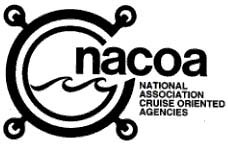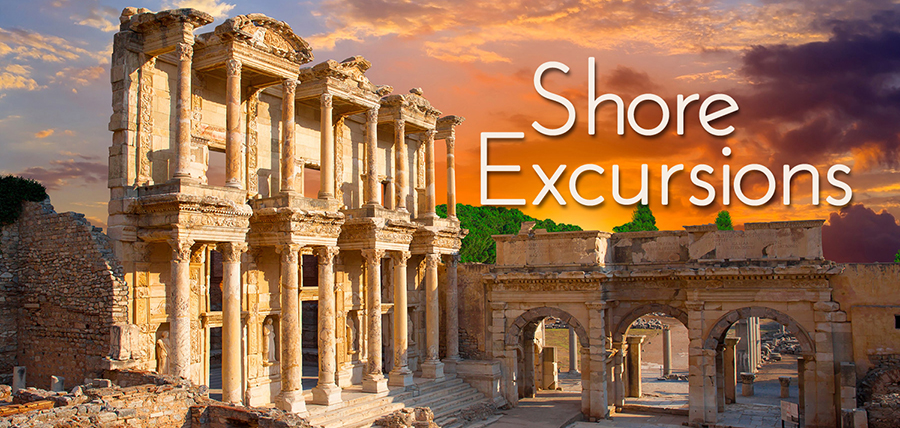
SHORE EXCURSIONS
"SACRED MYSTICAL GREECE"
|
DESCRIPTION |
LEGENDS OF THE GODS
|
Olympia/Katakolon
"Home of the Olympics and Temple of Zeus"
Wed. Oct. 4, 2023
8:15 am to 1:30 pm
Activity Level: Moderate
$189 per person
REGISTER HERE NOW
Tour Description
A short drive with your private guide from the port of Katakolon will bring you to the ancient city of Olympia, and to one of the most important sanctuaries of antiquity dedicated to Zeus, the father of the gods.
Olympia is the birthplace of the Olympic Games, and where they were hosted every four years for over 12 centuries. The area, of great natural beauty, has been
inhabited uninterruptedly since the 3rd millennium B.C. In the late Mycenaean period (1600 B.C. to 1100 B.C.) it became a religious center.
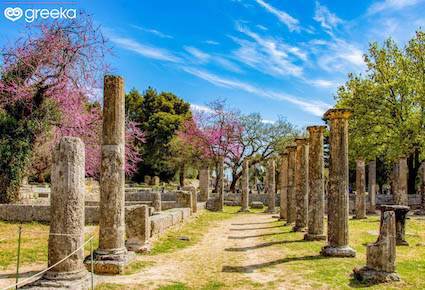
Once at Olympia you'll visit the most important archaeological sites of the Temples of Zeus and Hera (the wife of Zeus and queen of the ancient Greek gods), the Council House (an assembly house for local legislators), the Shrine of Pelops (king of Pisa in the Peloponnese), the Treasury, Palaestra, Gymnasium, Guest House, Priest's House, and the Stadium with its starting line made of stone.
After visiting the ancient monuments, you'll tour the museum to view the collection of statues, pediments, and sculptures from the site, including the magnificent statue of Hermes by Praxiteles, an outstanding masterpiece standing in the museum's place of honor.
After exploring Olympia, you'll return to the port of Katakolon to rejoin your ship.
The tour includes transportation to and from Olympia and entrance fees. Souvenirs and snacks are not included in the cost of the trip and will be at your expense.
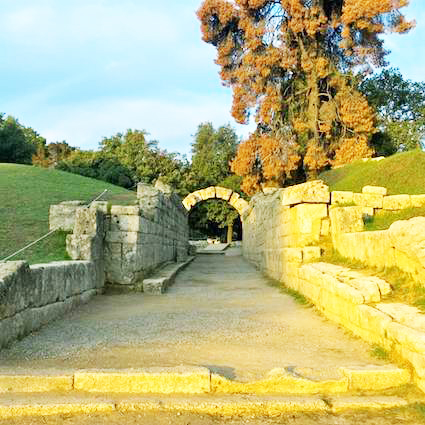
Food and Beverage
Not Included
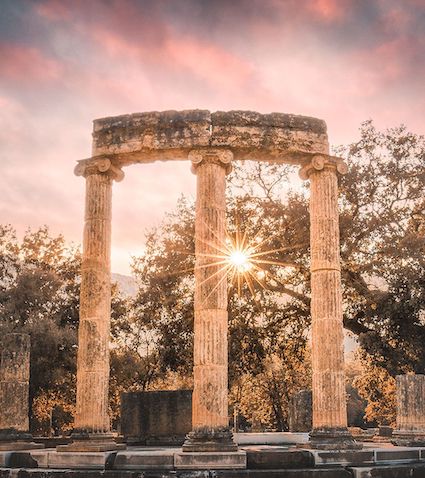
Recommended Dress
We recommend wearing comfortable clothing and sensible, flat-soled walking shoes. Sunscreen, hat and sunglasses are also recommended.
Restrictions
Guests must be able to walk over paved, gravel, stones and packed dirt surfaces. Many are uneven and/or on inclines. There are some uneven steps. At the site, walking will be over even and uneven surfaces, rough ground. At the Museum walking will be on paved surfaces. This tour is not wheelchair accessible but is suitable for those physically assisted. WC facilities are available at the Archaeological site.
Meeting Instructions
Details will be provided on your ticket.
REGISTER HERE NOW
|
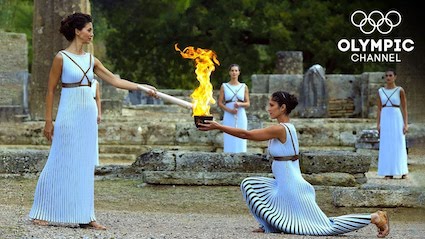
Legend of Olympia
According to the great Greek geographer Pausanias, the Olympic Games were first organized after Zeus was born to Kronos and Rea. Kronos wanted to eliminate Zeus, fearing that his son would overthrow him when he grew up. To avoid this, Rea took baby Zeus to mount Idi, in Crete. This is where five brothers, known as the Idaean Dactyls, lived, and Rea put them in charge of raising Zeus.
In an attempt to keep the young god entertained, the brothers organized a race. The contest was held in Ancient Olympia. The oldest brother, Heracles, set the location and the dimensions of the racing stadium. At the end of the race, the winner was crowned with an olive wreath. Zeus became the King of Gods, and the Games were held in his honor. The olive wreath became a symbol for peace.
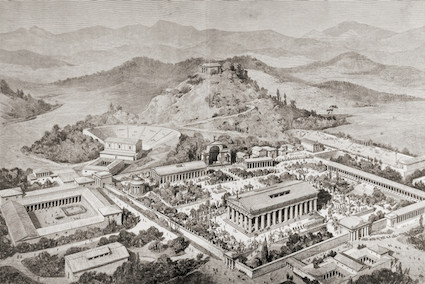
Another legend is that the mythical Hercules was involved in starting the Olympic Games. Hercules was a demi-god, the son of Zeus and Alcmene, a mortal woman.
Zeus had tricked Alcmene into sleeping with him, taking the form of her actual husband, Amfitryon. When Hercules was born, Zeus’ wife Hera was very jealous of her husband’s endless infidelity. She sent two snakes to the baby’s cradle in order to kill him, but Hercules managed to exterminate them.
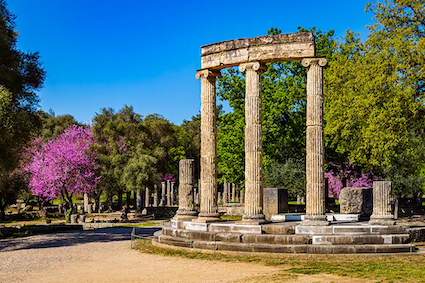
But this was not the end of Hera’s jealousy. When he grew older, Hercules married Megara, daughter of the king of Thebes.
They had several children and would have lived a happy life, if it weren’t for Hera. She brought madness upon Hercules, who eventually killed his wife and children.
The only way to purify himself of this sin was to serve the king Eurystheus for 12 years. Hence the 12 labors of Hercules.
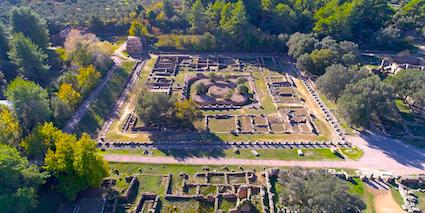
According to the ancient Greek lyric poet Pindar, Hercules established the Olympic Games after he had completed his 12 labors. The purpose of the Games were to honor his father, Zeus.
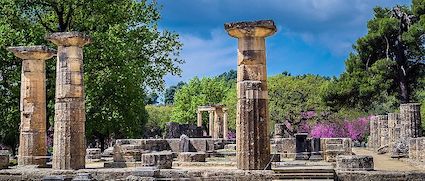
The first Olympic Games were held in Ancient Olympia in 776 B.C. From then on, the Games were held every four years. During the Games, a truce was established among all city-states, even during war times. This truce, called "Ekehiria," enabled travelers to reach their destination safely.
Olympia and the wider area of Elis were neutral grounds. They served as a sacred space, where peace, freedom, equality, and respect prevailed.
The Games were last held in 393/394 A.D.
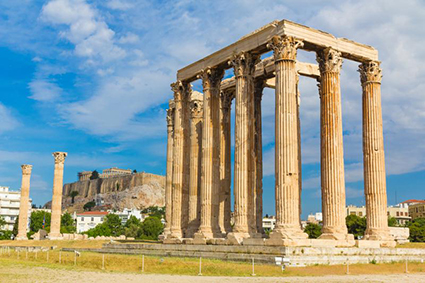
REGISTER HERE NOW
|
|
Santorini, Greece
"The Lost City of Atlantis Found?"
Thur. Oct. 5, 2023
8:30 am to 4:15 pm
Activity Level: Moderate
$319 per person, including lunch
REGISTER HERE NOW
Tour Description
With its fascinating geography, more than 5,000 years of history, and unique hospitality, our tour on Santorini features a professionally trained, licensed guide to give you an in-depth experience. You
will meet your guide on the pier of Fira after you tender ashore. They will escort you via
cable car to the town of Fira where you will walk to your transportation.
Departing Fira, you will make your way to the charming village of Oia (E ah) located at the very north end of the caldera. You will arrive as the town is waking up and before the wave of tour buses arrives allowing you to see/experience the charm of the village. You will have approximately 60 minutes to stroll the multileveled sidewalks and pedestrian streets that weave their way through this hillside village.
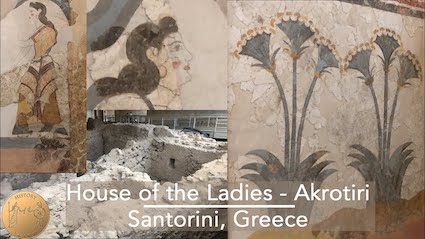
Stop for a Greek coffee in one of the numerous small cafes, window shop, or watch the ever-changing color, light, and shadows as they splash across the blue water, whitewashed buildings and the dramatic cliffs of this town cling to. As you are leaving Oia, you will get a glimpse of the mob that will descend upon this small village later in the day.
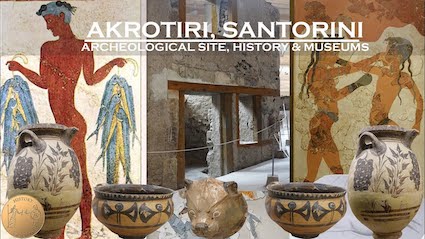
You will drive south through the famous vineyards to the archaeological site of Akrotiri. The site is a Minoan settlement that dates back to the second millennium B.C. The name of the settlement is unknown, but the excavation is named Akrotiri due to its proximity to a modern village of that name. Evidence uncovered points to the settlement had once been an important commercial center in the Aegean Sea.
The settlement was buried under more than 30 feet of dirt, rock, and mud during a cataclysmic eruption that resulted in a large crater (caldera) replacing more than half of the island. Under a protective cover, you will visit the ancient city's squares and cobblestone streets, and peer into some of the houses and shops, some two and three stories high. No human remains have been found, indicating there was some warning before the eruption.
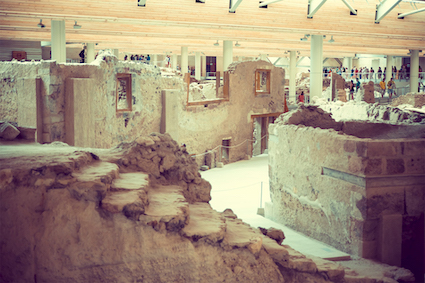
After the guided tour of the excavation site, you will drive to a nearby restaurant where you will enjoy a typical lunch of Greek favorites, local wine, and a panoramic view of the island.
After lunch you will drive through the adjacent village of Pyrgos, another one of the island's most popular sites due to its winding streets and whitewashed houses accented with vibrant Mediterranean colors and flowers.
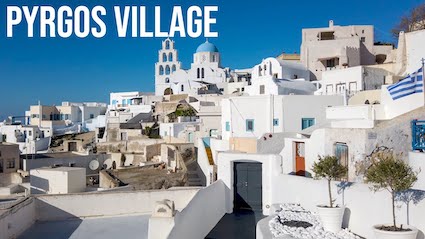
Next, you will drive to Fira town where your day will continue with a visit to the Prehistoric Museum. Thira is the earlier name for the island of Santorini. The museum houses finds from the excavation site of Akrotiri, as well as other sites on the island. The exhibition is structured in four units, referring to the history of research at Thira, the geology of Thira, the island's history from the Late Neolithic to the Late Cycladic I period and the heyday of the city at Akrotiri. The exhibits include fossils of plants that flourished before the human habitation of Thira as well as archeological objects dating back to 3300 B.C.
Your guide will lead you to the town's major pedestrian street, and after answering any questions about additional sightseeing, shopping, or eating, will set you free to explore the whitewashed maze of passageways for art, jewelry, or maybe a coffee with a view of the caldera. When you are ready to return to your ship, use your included cable car ticket to return to the tender pier in Fira.
Food and Beverage
Lunch is included.
Recommended Dress
We recommend wearing comfortable clothing and sensible walking shoes. Sunglasses and sunscreen are also suggested.
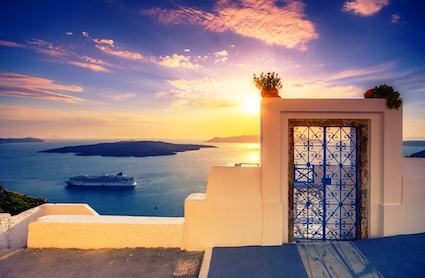
Restrictions
Fira, as well as most of the island's villages, is a hilltop town that consists of mostly pedestrian streets. These "streets" are nothing more than wide sidewalks of smooth stones pushed into cement which makes for a bumpy surface. To reach the town from the tender pier, guests can ride the cable car to the town, which is more than 1,100 feet above the harbor. Expect long lines for the cable car. The site of Akrotiri includes steps.
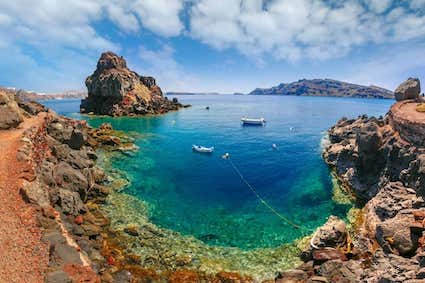
Meeting Instructions
Details will be provided on your ticket.
REGISTER HERE NOW
|
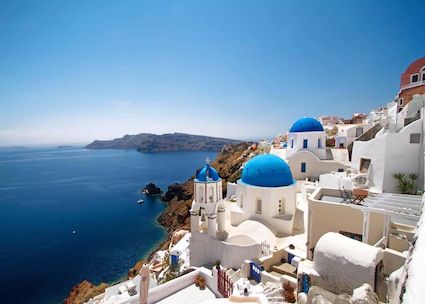
Legend of Atlantis
Santorini has often been connected with Atlantis, the legendary continent that plunged to the bottom of the sea while at its zenith of power. The mystery surrounding the destruction of Thera and the disappearance of Atlantis has preoccupied humanity for generations.
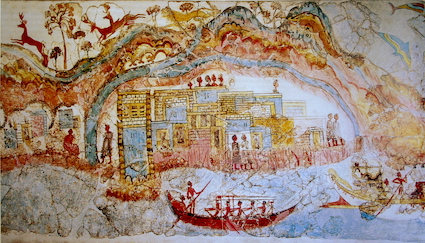
Plato tells us of an Athenian lawyer, Solon, who visited Egypt (590 B.C.) where he was told the story of Atlantis by a priest at Sais: "A great and wonderful state that ruled over the other islands," which owed its power to the civilization that had evolved there.
The kingdom consisted of two islands, the "larger" (possibly Crete) and the "smaller" (possibly Thera, now known at Santorini), with ten cities. Two were mentioned specifically: the "Metropolis" and the "Royal City."
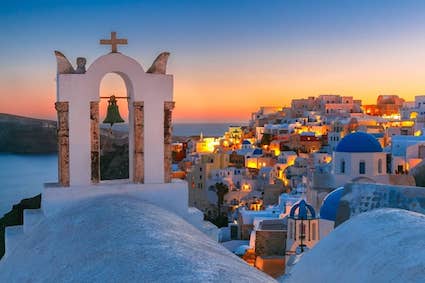
The people of Atlantis launched an attack on Athens 900 years before Solon talked to the priest. But the Athenians defeated them and liberated all the lands that Atlantis had conquered.
Later Atlantis suffered a terrible earthquake and a flood, sinking entirely into the sea. Finds from the excavations at Akrotiri have led scholars to conclude that the lost Atlantis was none other than Santorini.
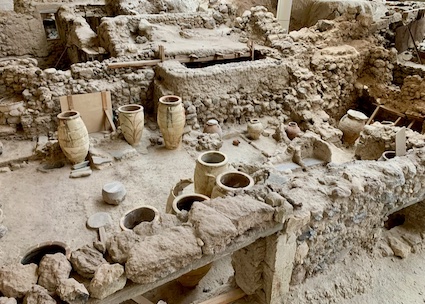
According to scientific research, the volcanic eruption that devastated Thera took place in the 16th century B.C.. According to ancient legend, there was a lava titan imprisoned inside the Methana Volcano outside of Atlantis by Poseidon. She appears to be the core of the volcanic activity within the mountain.
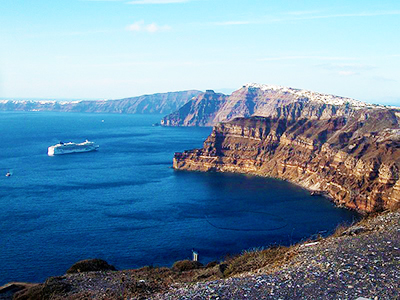
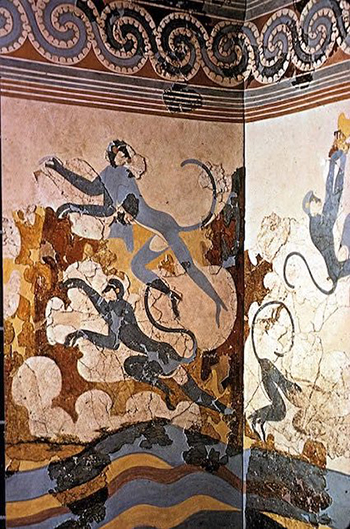
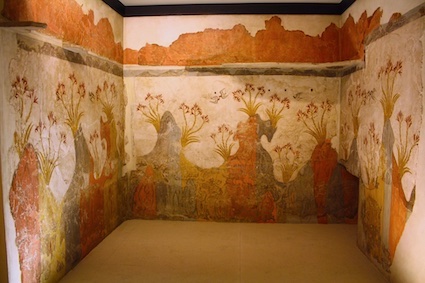
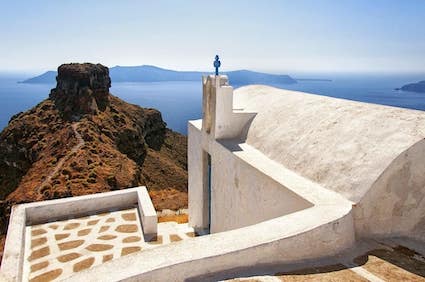
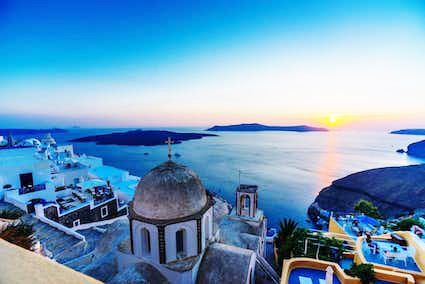
REGISTER HERE NOW
|
|
Kusadasi, Turkey
"Cult of Artemis—The Fertility Goddess"
and Ceremony with Denise Linn
Fri. Oct. 6, 2023
8:45 am to 1:00 pm
Activity Level: Moderate
$169 per
person
REGISTER HERE NOW
Tour Description
Meet your professionally trained guide and drive to Ephesus, approximately 30 minutes from Kusadasi. Famous in antiquity for its Temple of Artemus during the years of the Roman Empire, the Greek port of Ephesus became the greatest city in Asia Minor.
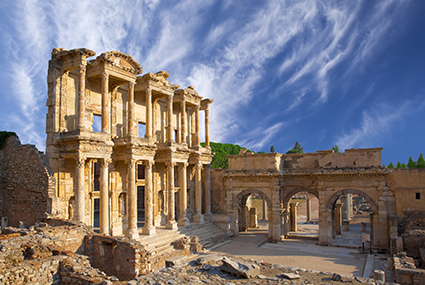
You will start your 90 minute Ephesus tour at the upper Magnesia Gate, and work your way down through the city, ending near the ancient Harbor.
Along the way you will see the Forum, the Odeon, the Library of Celsus, the Thermal Baths of Scolastika and the Great Theater, built in the Greek era and reconstructed in the Roman period.
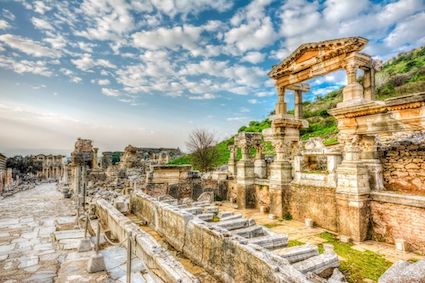
It has played host to programs as varied as Paul and his sermons to the Ephesians, to concerts by Sting, in part due to its remarkable acoustics.
You will walk along the Arcadian Way, where once Mark Antony and Cleopatra rode in procession. You will hear stories of Alexander the Great, the Virgin Mary, and many other famous visitors who walked the same marble streets that you are walking.
As you depart the Ephesus site, you will be able to view the hilltop ruins of the Basilica of St. John in the distance, which was erected over his grave in the 6th century A.D. by Emperor Justinian.
Entrance to the Library of Celsus is included.
You will also visit the Temple of Artemis, whose former glory as one of the 7 Wonders of the World has been reduced to one pillar after devastating pillage and plunder.
Returning to the town of Kusadasi, guests will have the option to end their tour in the shopping area where they can explore the shops filled with jewelry, carpets, leather ware, and copper goods, or both. Turkish salespeople expect you to haggle and quite often you can get 10-15% off the listed price. Treat it as an adventure. The cruise pier is a 5-10 minute walk from the main shopping area.
Food and Beverage
Not Included
Recommended Dress
Comfortable clothing and closed-toe, sensible walking shoes are recommended. Sunglasses, sunscreen, and a hat or umbrella are suggested.
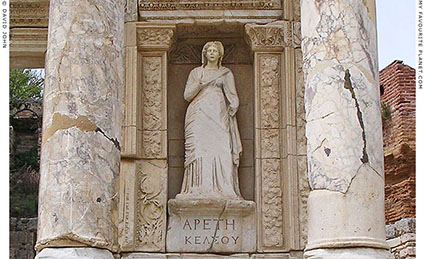
Restrictions
Walking at Ephesus is over actual streets / sidewalks from ancient times which are uneven and worn. There are steps without handrails and packed dirt that must be navigated in some areas. The walk through Ephesus is not wheelchair accessible.
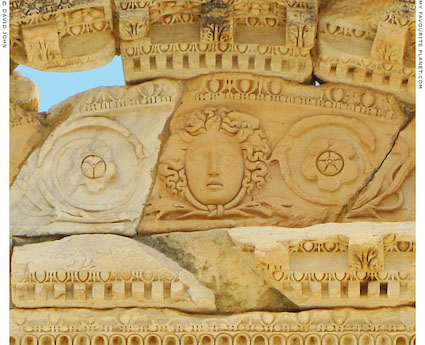
Meeting Instructions
Details will be provided on your ticket.
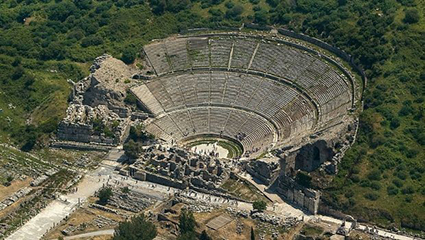
|
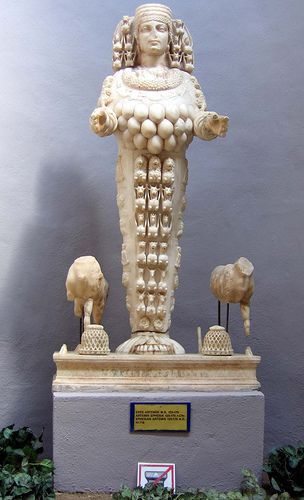
Legend of Artemis
Artemis is the daughter of Leto and Zeus, and Apollo's twin. She is the goddess of the wilderness, the hunt, wild animals, and fertility. She is the midwives' helper and goddess of birth.
In one legend, Artemis was born one day before her brother Apollo. Right after her birth on the island of Ortygia, she helped her mother Leto to cross the straits to Delos, where Leto then delivered Apollo. Thus began Artemis' role as guardian of young children and patron of women in childbirth.
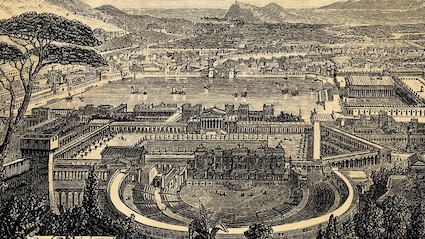
As a goddess of contradictions, Artemis protected women in labor, but her arrows brought them sudden death during childbirth. Like her twin brother Apollo, Artemis was a god of healing, but also brought and spread diseases.
The immortal Artemis and Apollo killed the children of the mortal Niobe, who had boasted to Leto (mother of the divine twins), that because she had more children than Leto, she was superior to her. When Apollo was outraged by this insult, the twin gods hunted and shot them with their bows and arrows. Apollo killed the male children and Artemis the females.
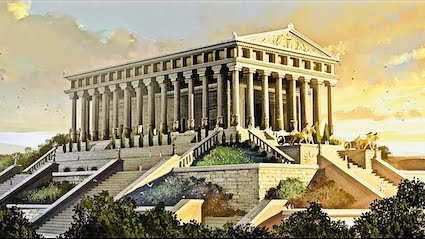
Artemis was worshiped in most Greek cities but only as a secondary deity. However, to Greeks in Asia Minor, she was a prominent deity. In Ephesus, a great temple was built in her honor—one of the "Seven Wonders of the Ancient World." There she was worshipped as a fertility goddess, and was identified with Cybele, the mother goddess of Eastern lands.
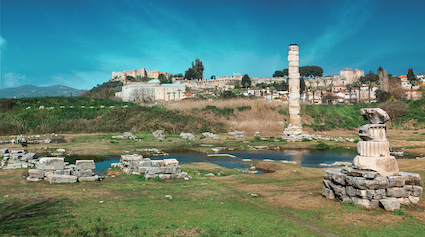
The cult statues of the Ephesian Artemis differ greatly from those of mainland Greece, where she is a huntress with bow and arrows. Those at Ephesus show her in the Eastern style, standing erect with numerous nodes on her chest.
Some say they are breasts, others say they are bulls testes sacrificed to her. Though the true interpretation remains uncertain, we can conclude that they represent fertility.
Artemis at an early age asked her father Zeus to grant her eternal chastity. Also all her companions were virgins. Artemis was very protective of her purity, and gravely punished any man who attempted to dishonor her. Actaeon, while hunting, accidentally came upon Artemis and her nymphs, bathing naked in a secluded pool. The stunned Actaeon stopped and gazed at them, but when Artemis saw him ogling them, she transformed him into a stag. Then she set his own hounds upon him.
They chased and killed what they thought was a stag, but it was really their master.
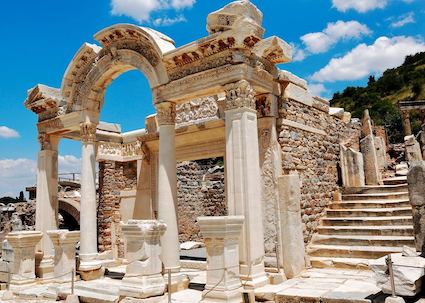
Legend is that Orion, a giant and a great hunter, tried to rape the virgin goddess, so she killed him with her bow and arrows. Another legend says she conjured up a scorpion which killed Orion and his dog. Orion became a constellation in the night sky, and his dog became Sirius, the dog star. Yet another version says the scorpion stung him and was transformed into the constellation Scorpio.
REGISTER HERE NOW
|
|
Island of Delos, Greece
"Most Sacred Island—Birthplace of Apollo and Artemis"
with Denise Linn
Sat. Oct. 7, 2023
8:45 am to 1:30 pm
Activity Level: Moderate
$229 per
person
REGISTER HERE NOW

Tour Description
Board your boat at Mykonos and skid across calm waters to the uninhabited island of Delos. Considered one of the most important mythological, historical, and archaeological sites in Greece, Delos held a position as a holy sanctuary millennia before Olympian Greek mythology made it the birthplace of Apollo and Artemis.
The tiny island of Delos opposite of Mykonos Island, where its Apollonian sanctuary was established since the 9th century B.C., was a center of culture well before the Golden Age of Pericles and the Parthenon. Time on Delos is forever frozen, and this tour offers the rare opportunity to stroll in the footsteps of the ancient Greek gods.
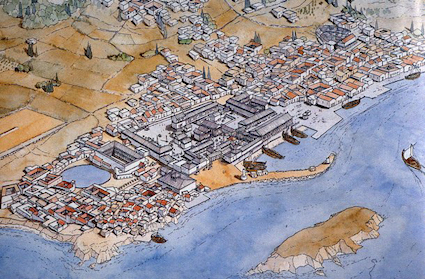
In this stark and lonely landscape, you will explore the ruins of an ancient settlement that once bustled with trade and commerce. Your guide will tell the tale while standing before the remnants of the Great Temple of Apollo. You will visit the island's most impressive highlights, from the Sanctuary of Apollo to the houses of Dionysus and Cleopatra.
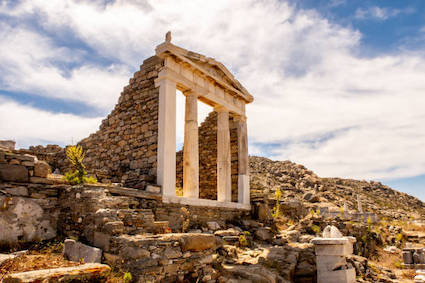
Tour the classical Theater, where over 5,000 citizens once cheered epic performances.
See Hellenistic mansions adorned with elaborate mosaics crafted thousands of years ago. Look out upon the greens and blues of the archipelago from the Terrace of the Foreign Gods and visit the lost Sacred Lake, which today stands dry, and where it is said that once swans and geese of Apollo frolicked.
Those who have walked along the 164-foot-long Avenue of the Lions, with its five Naxian marble beasts crouching on their haunches, forelegs stiffly upright, vigilant guardians of the Sacred Lake, who have gazed at the marble columns of its temples, and have stood amidst the Agora and the remains of this once cosmopolitan Greek city, know why this unique island was named a UNESCO World Heritage Site.
Food and Beverage
Not Included.
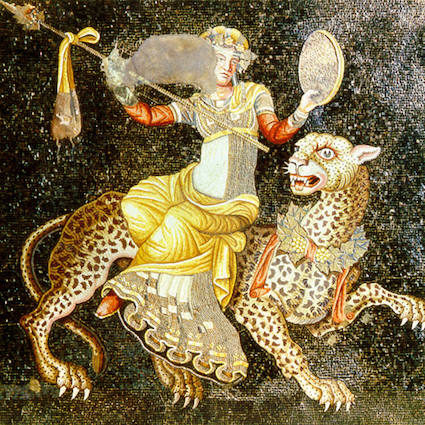
Recommended Dress
We recommend wearing comfortable clothing and sensible, flat-soled walking shoes. Sunscreen, hat or umbrella, and sunglasses are also recommended as it can get very hot on Delos. Please cover your knees and shoulders if visiting a religious site.
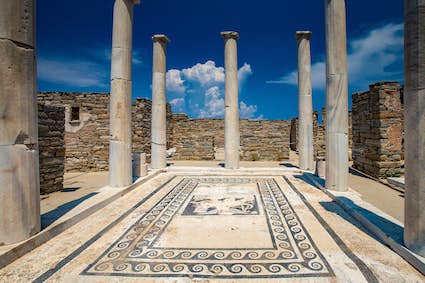
Restrictions
Guests must be able to walk over cobblestones and uneven surfaces, inclines and steps. Guests must be able to get in and out of transportation. This tour is not wheelchair accessible because of the varied terrain at the sites you will be visiting.
Meeting Instructions
Details will be provided on your ticket.
REGISTER HERE NOW
|
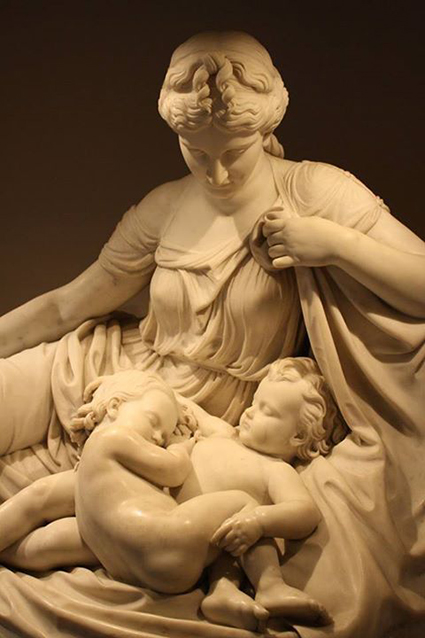
Legend of the Twins Apollo and Artemis
A small, rocky island in the center of the Aegean Sea, where, by law, no one is allowed to live, Delos was considered "the most sacred of all islands" in ancient Greek culture. According to legend, Apollo-Sun, god of daylight, and his twin sister Artemis-Moon, goddess of night light, were born here.
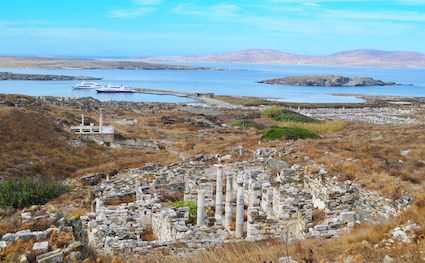
Where Leto gave birth to Zeus’s children Apollo and his twin sister Artemis, the sun shines brightly and illuminates both mind and soul. It is perhaps why, at this second "Navel of the Earth," like at its sister site Delphi, we can truly see ourselves.
Delos gave birth to Light, the most valued commodity in Greek civilization, and here the worship of the light-giving God Apollo was centered. This small rock in the middle of the vast sea became the most famed and sacred place in the known world for three centuries.
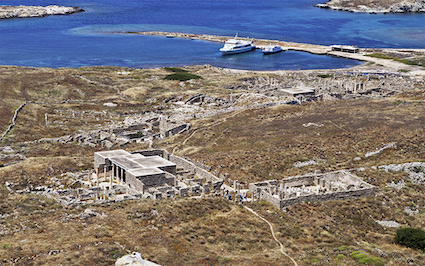
After the advent of Christanity, Delos was abandoned and over the years became deserted. Yet the deep footprints left by centuries of worship could not be erased by time nor neglect. Delos unveils itself with each sunrise, its soul unchanged, captivating, sacred. And when the light finally dips back into the sea at the end of the day, it stands alone and proud, softly whispering of its past grandeur.
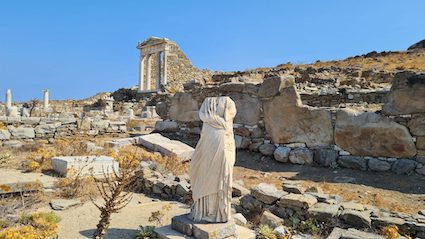
Delos is directly and tangibly associated with one of the principal myths of Hellenic civilisation. It was on this arid islet that Leto, impregnated by Zeus and fleeing the vengeance of Zeus's wife Hera, gave birth to Apollo and Artemis after a difficult labor. According to a Homeric hymn, the island, which until then had been floating, became anchored to the floor of the ocean.

The newborn Phoebus-Apollo threw off his swaddling clothes, bathed the universe in light, and began walking with his cither and bow. Kynthos, the mountain of Zeus, and the wheel-shaped lake, close to which Leto suffered labor pains for nine days and nights, remain essential landmarks of the island's sacred geography, which was clearly defined by the additions made to the Delian sanctuary to Apollo between the 6th and the 1st centuries B.C.
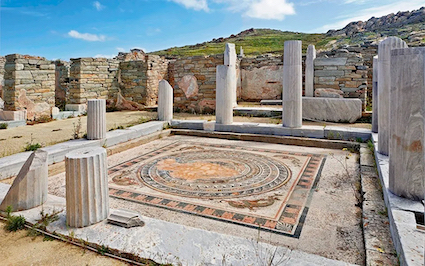
REGISTER HERE NOW
|
|
Souda, Crete, Greece
"Labyrinth of the Minotaur: Knossos Palace and Heraklion"
Sun. Oct. 8, 2023
8:15 am to 5:00 pm
Activity Level: Moderate
$319 per
person
REGISTER HERE NOW
Tour Description
After meeting your professional guide, you will depart the commercial port area and drive two hours until you reach the town of Heraklion. There you will have glimpses of its bustling narrow pedestrian streets and market areas.
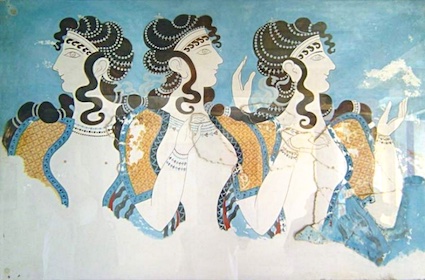
South of Heraklion is one of Crete's finest archaeological sites: Knossos, the ancient capital of the great King Minos and the largest and most spectacular of Minoan Palaces.
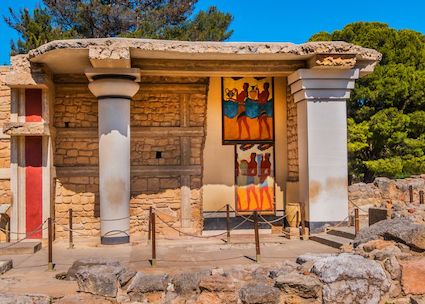
With its 20000 square meters, 1300 rooms, and 5 floors, it is the largest Minoan building ever built. The site was excavated by Minos Kalokerinos of Herakleion in 1878 and continued by famous English archaeologist Sir Arthur Evans in the 1920s.
Its ruins are unique due to the variety of materials and the beautiful still-existing decorations that adorn it. The best-known frescoes are the “Bull Jumping” and "The Prince of Lilies," which colors are still stunningly intact. One interesting area are the Queen’s Baths, with a modern sewage pipe system and wonderful decorations.
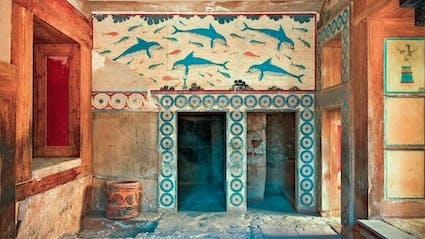
The original Palace of Knossos was constructed around 1900 B.C., but a few hundred years later, an earthquake destroyed it. In its place, another palace was built on an even grander scale. In 1900, restoration, undertaken by Sir Arthur Evans, which was controversial at the time, offered great insight into the complexity of Minoan life nearly 4,000 years ago.
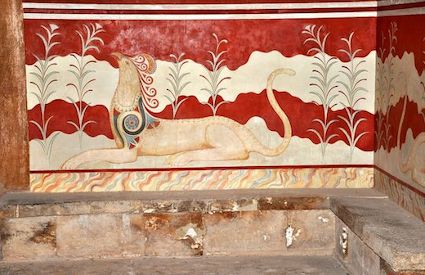
You will take a private tour of the Palace of Knossos ruins that consist of four wings, spread out from a central court, a complex that once served as the administrative and religious center for the whole region.
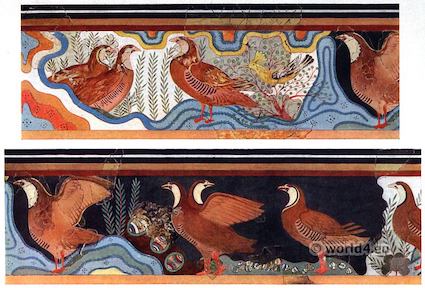
As you tour the labyrinthine site, you will see the royal living quarters, rooms where state occasions were held, a theater area, storerooms and workshops, as well as indoor plumbing from more than 3,000 years ago.
Following your tour, you will rejoin your transportation for the return drive to the commercial port of Heraklion town. The group will have lunch in Heraklion and then return to the pier in Souda, Crete..
Food and Beverage
Lunch Included
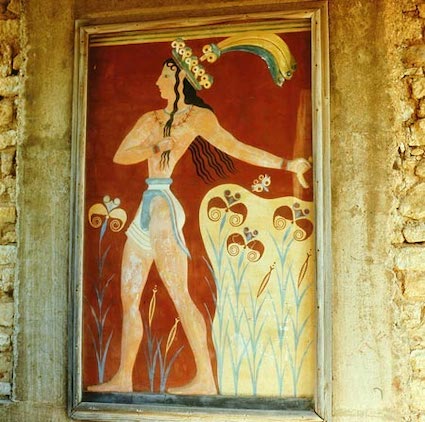
Recommended Dress
Comfortable clothing and sensible, flat-soled walking shoes, sunglasses, sunscreen, and hat or umbrella are suggested.
Restrictions
Guests must be able to walk over uneven paved, cobblestone and packed dirt surfaces. There are numerous steps up and down required to tour the ruins.
Meeting Instructions
Details will be provided on your ticket.
REGISTER HERE NOW
|
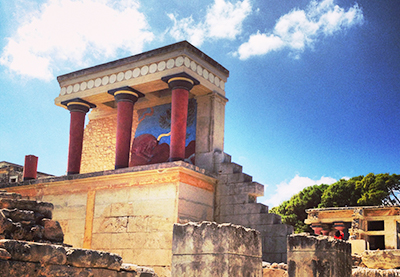
Legend of the Minotaur
King Minos was one of three sons of the union of Europa and Zeus. Europa's husband was King of Crete, Asterion, who treated her sons as his own. When Asterion died, the sons competed over who would ascend the throne. Minos boasted of his worthiness because of his special power that his prayers would always be answered. To prove this, Minos prayed to Poseidon that a bull would appear from the depths of the sea. In exchange, Minos vowed to sacrifice the bull to Poseidon.
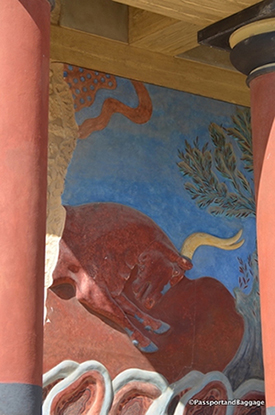
But after the magnificent white bull appeared, Minos did not keep his promise. He ascended the throne, kept the bull, sacrificed a substitute bull to Poseidon, and banished his brothers from Crete. Poseidon, angered by King Minos' hubris, punished him by enlising Aphrodite to instill passion for the bull in King Midos' wife, Pasiphae.
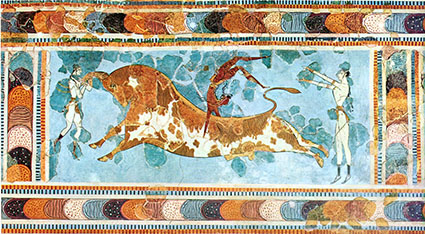
Queen Pasiphae sought to quench her lust by soliciting help from Daedalus and his son Icarus to construct a wooden cow on wheels, covered by a cow hide. She hid inside the structure and was wheeled onto the meadow where the bull grazed. The bull thought she was a real cow and mated with her. Thus the Minotaur was born—a mythical figure with a man's body and a bull's head and tail.
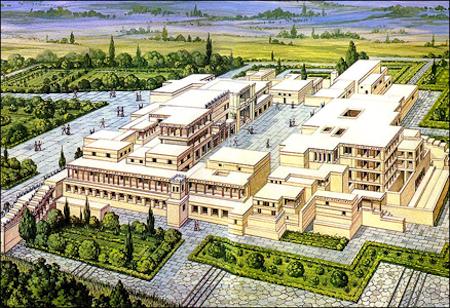
When King Minos saw the beastly infant, he enslaved Daedalus and Icarus as punishment. As the beast grew increasingly ferocious and monstrous, Minos ordered Daedalus and Icarus to build a huge maze known as the Labyrinth to imprison him. Because Minos blamed the Athenians for the death of his only son Androgeos, he ordered Athens, which had just been defeated in war, to send 7 girls and 7 boys into the labyrinth each year to feed the monster.
As the maze was extremely labyrinthine, Dedalus and Icarus were imprisoned by it and could only escape by flying away, using the wings that Icarus had just finished building.
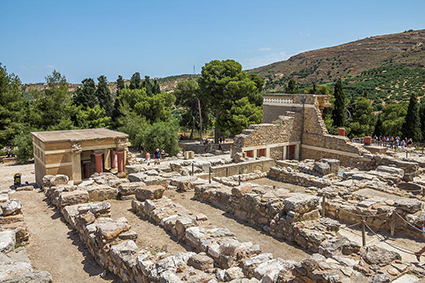
The Athenian hero Theseus boasted that he would slay the Minotaur. He arrived in Crete, hiding himself in the third tribute of youths. The king’s daughters Ariadne and Phaedra fell in love with him. With advice from Dedalus, Ariadne told Theseus how to escape the Labyrinth. With Ariadne’s ball of thread, Theseus found the monster, killed him, and followed the thread to exit the labyrinth.
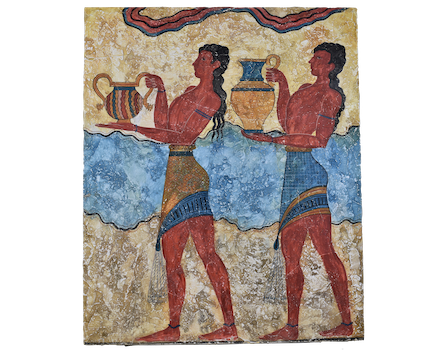
The beautiful Palace of Knossos was built on top of the hill. The complicated planimetry of the building made it almost impossible to get orientated. This suggests that Knossos could be the place that had inspired the popular Minotaur legend.
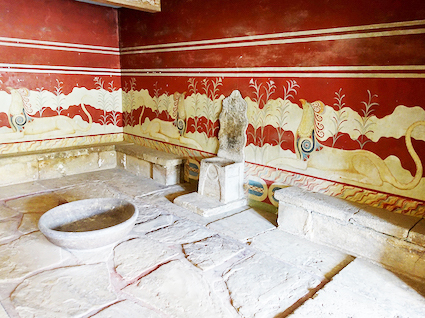
REGISTER HERE NOW
|
 |
|
Piraeus, Greece
"Oracle of Delphi - The Navel of the Earth"
and Ceremony with Denise Linn
Mon. Oct. 9, 2023
5:45 am to 5:00 pm
Activity Level: Strenuous
$249 per
person
REGISTER HERE NOW
Tour Description
After meeting your professionally trained and licensed guide, you will begin your journey to Delphi. Along the way, you will see the plain of Beotia, an agricultural center surrounded by cotton plantations, and you will pass through the city of Thebes, the birthplace of Hercules and King Oedipus.
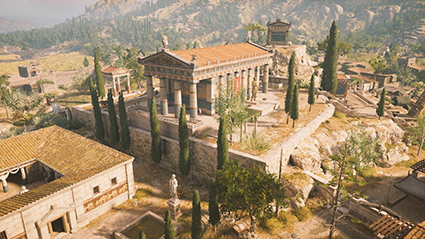
You will continue towards Mt. Parnassos, making a brief rest stop outside the town of Levadia.
You will then drive on to Delphi, whose allure is amplified by an amazing hillside setting and ruins that will intrigue even the most skeptical.
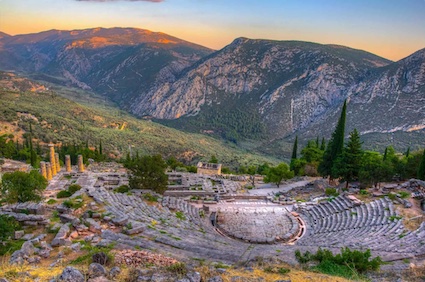
Delphi was the home of the Oracle of Delphi (the Greek world's most important oracle), and the priestess Pythia, famed throughout the ancient world for divining the future and for consulting in all major undertakings.
The area was a religious sanctuary dedicated to the Greek god Apollo after he slew the Python, a deity who protected the navel of the Earth (center of the world) in this location. The sanctuary was home of the Pythian Games, the second most important games in Greece after the Olympics.
When visitors approached Delphi, the first structure they saw was the sanctuary of Athena Pronaia — meaning, "Athena who is before the temple (of Apollo)." This sanctuary contained the most characteristic monument at Delphi: the Tholos, a circular building with a conical roof supported by a ring of outer columns.
Visitors would then walk along the Sacred Way, a path to the sanctuary of Apollo that was lined with treasuries and votive monuments.
The central and most important part of Delphi was the temple of Apollo, where the Pythia delivered her prophetic words in the adyton, a separate, restricted room at the rear. The temple of Apollo sat atop a large terrace supported by a polygonal wall.
As you tour the site with your professional guide, they will bring to life the history and central characters of the site. You will see the Roman Agora, walk along the Sacred Way, and view the monument of the Argive Kings, the treasury of the Athenians, the Athenian Stoa, the Polygonal Wall, the monument of Platea, and the Temple of Apollo where the oracle resided.
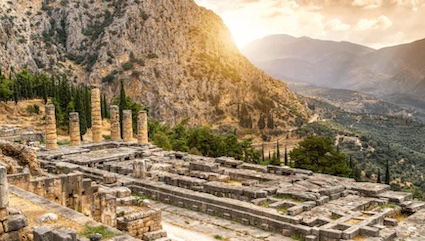
Above the Temple, you can visit the well preserved 3rd-century Theater. On the lower slope of the mountain is the Tholos, a building whose purpose is unknown but architecturally speaking is considered one of the masterpieces of the ancient world. You will also see the Palestra where the athletes trained in preparation for the Pythian Games.
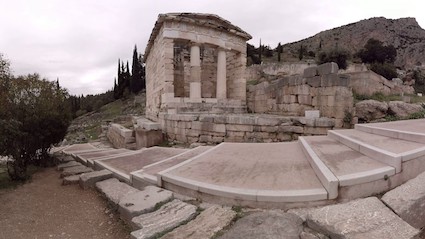
After you tour the site, you will visit the adjacent Delphi Archaeological museum, housing ancient artifacts found at the site. Its centerpiece are antiquities from the Oracle complex, which dates from the 18th century B.C. until its decline around 300 A.D. Exhibits include the frieze of the Treasury of the Sifnians, the Naxian Sphinx, the metopes of the Athenian treasury, and the Charioteer, created to commemorate a victory during the 476 B.C. Pythian Games.
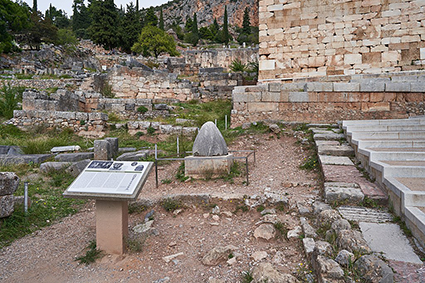
After you visit the museum, rejoin your transportation and begin the drive back to Athens. Along the way, a stop will be made for a traditional Greek lunch with wine. After lunch, you will start your drive back to the port of Piraeus.
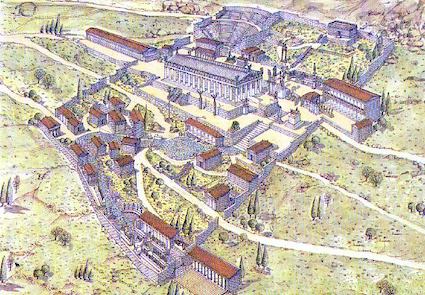
Please Note
The drive to and from Delphi is approximately 3 hours each way. Stops will be made along the way. The site of Delphi is perched on the side of a steep hill and is visited by uphill walking. Those who make the climb are rewarded with a beautiful view over the site and the valley beyond.
Food and Beverage
A traditional Greek lunch with wine is included.
Recommended Dress
Comfortable clothing, sensible, flat-soled walking shoes, sunglasses, sunscreen, and hat or umbrella are suggested.
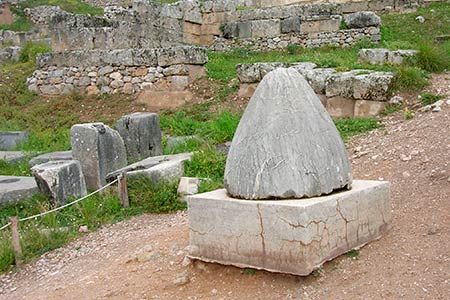
Restrictions
The hillside site of Delphi requires almost continuous uphill walking over dirt and some paved surfaces to visit. Guests must be in good health and sensible walking shoes are a must. At the museum, there are steps to enter the building.
Meeting Instructions
Details will be provided on your ticket.
REGISTER HERE NOW
|
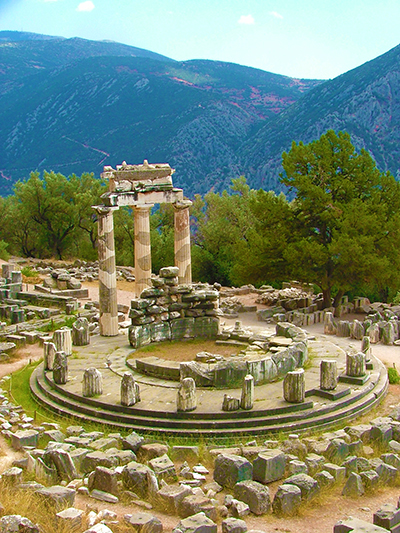
Legend of the Oracle
According to Ancient Greek myths, the god Zeus launched two eagles from the two ends of the world, one to the east and the other to the west, in order to find the center of the earth. The eagles, starting simultaneously and flying at equal speed, crossed paths above Delphi. Zeus marked the spot with a sacred stone called the omphalos (meaning "navel"), which was later held at the sanctuary of Apollo. Since then, Delphi has been considered to be the center of the world, the omphalos—"Navel of the Earth."
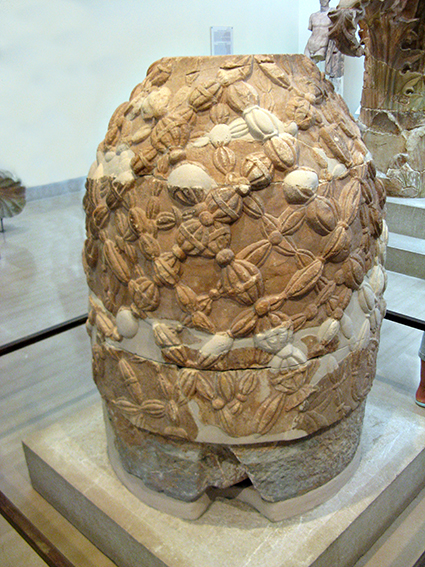
The omphalos is an ancient marble artifact, found at the archaeological site. The original stone is held in the museum of Delphi. A simplified copy sits outdoors at the site where it was found.
In the 2nd century A.D., Pausanias traveled to Delphi and provided rare evidence through his work.
The oval-shaped stone of the omphalos seems to have been decorated in high relief. In ancient times it may have been covered by a mesh of wool cloth, and was kept in the adyton (inner sanctum), beside the tripod and the daphne (bay leaves)—the other sacred symbols of the god. Pausanias described the wool cloth that covered the stone held precious stones designed in the shape of a mermaid, while two gilded eagles were fixed on top of it.
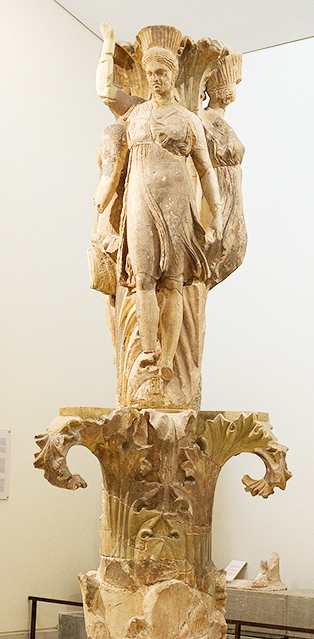
Recent studies by French archaeologists have shown that the omphalos and columns were connected and interlocked. The stone navel was mounted on the bronze tripods supported by the three dancers at the top of the column. This is where the omphalos is thought to have been placed, as a cover of the column, in order to reinforce the meaning and importance of the Athenian votive offering symbolically. The Athenians, wanting to placate and honor the god of light, offered Apollo this copy of the original stone, which combined both Delphic symbols as a gift from the hands of the three priestess figures.
Greeks believed the site was sacred and belonged to Gaia, or Mother Earth, and was guarded by Gaia’s serpent child, Python. Apollo killed Python and founded his oracle there.
According to legend, natives of the island of Crete, accompanied by Apollo in the guise of a dolphin, arrived at the port of Delphi (Kirrha) and built the god’s sanctuary.
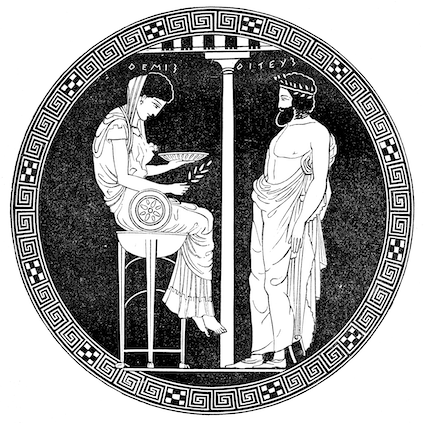
The prestige of the Oracle of Delphi was at its height between the 6th and 4th centuries B.C.
Delphi became a powerful entity, with both rulers and common folk seeking counseling with the Pythia, who only operated a limited number of days over 9 months of the year. These pilgrims brought lavish gifts and offerings. Due to high demand for the oracle's services, affluent people paid great sums to skip to the front of the line. The Oracle was consulted on both private matters and affairs of state. City-state rulers sought advice before launching wars or founding new Greek colonies.
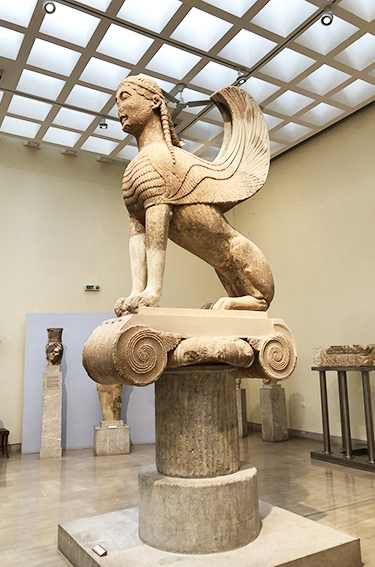
For these consultations, the Pythia would enter the adyton and then sit on a tripod chair, possibly behind a curtain. After Apollo’s priests relayed questions posted by petitioners, the Pythia would inhale light hydrocarbon gasses that escaped from a chasm in the ground, falling into a trance.
The Pythia would then mutter incomprehensible words, which the Apollo priests would translate sometimes conflicting messages for petitioners.
Greeks believed the Oracle of Delphi existed since the dawn of time and accurately predicted historical events such as the Argonaut’s expedition and Trojan War.
REGISTER HERE NOW
|
|
Zakynthos, Greece
"Paradise Island in the Ionian Sea"
Tues. Oct. 10, 2023
10:00 am to 3:00 pm
Activity Level: Moderate
$219 per
person
REGISTER HERE NOW
Tour Description
• Leave port and drive to port Agios Nikolaos Skinari – about 60 minutes
• Get on your private boat and sail to Shipwreck Beach for a photo stop
• On the return swim stop at Agios Andreas Beach and visit Blue Caves
Food and Beverage
Not Included
Recommended Dress
Comfortable clothing and closed-toe, sensible walking shoes are recommended. A bathing suit, sunglasses, and sunscreen are suggested.
Restrictions
Passengers need to be able to get on vehicles and vessels on their own
Meeting Instructions
Details will be provided on your ticket.
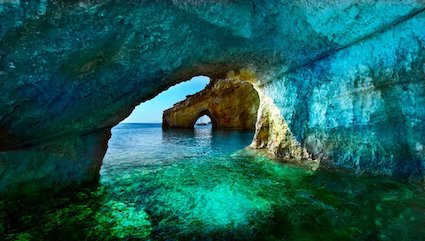
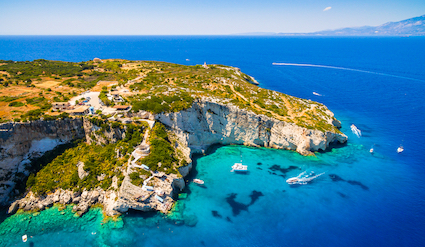
REGISTER HERE NOW
|
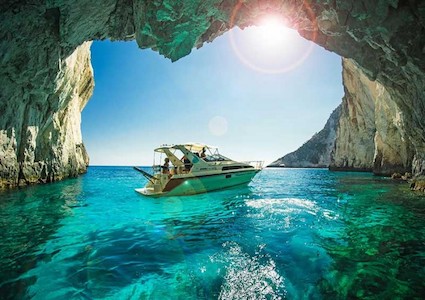
Heroes of World War II
During the World War II Holocaust in Greece, the entire 275-person Jewish population of Zakynthos were saved when Mayor Loukas Karrer and Bishop Chrysostomos (1890–1958) refused Nazi orders to turn in a list of the members of the town's Jewish community for deportation to the death camps. Instead they secretly hid the town's 275 Jews in various rural villages and turned in a list that included only their own two names.
In 1978, Yad Vashem, the Holocaust Martyrs' and Heroes' Remembrance Authority in Israel, honored Bishop Chrysostomos and Mayor Karrer with the title of "Righteous Among the Nations," an honor given to non-Jews who, at personal risk, saved Jews during the Holocaust. After the war, all of the Jews of Zakynthos moved to Israel or Athens.
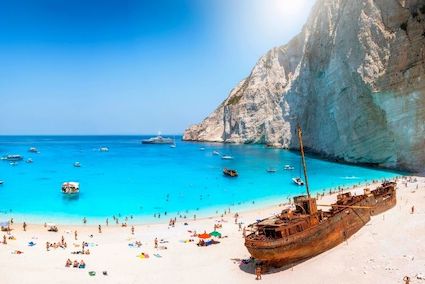
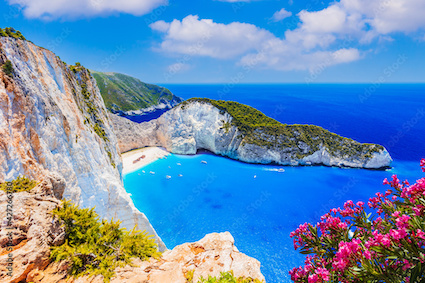
REGISTER HERE NOW
|
CLICK HERE TO REGISTER NOW
|




